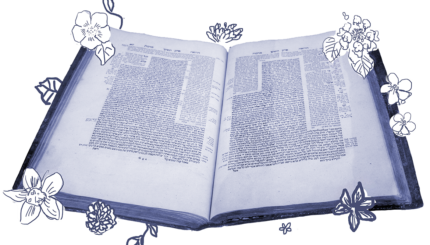With the holiday of Simchat Torah coming up, rabbinical student Becky Silverstein considers how the Jewish calendar lets her renew her relationship with the each year – and how it reminds her to use our sacred text as a tool, and not a weapon.
Eisegesis: an explanation of a text in which the interpreter’s own biases and assumptions are read into or placed upon the text.
As an educator who has worked mostly in experiential and informal educational settings, I know a lot of icebreakers and community building activities, not to mention name games. Last fall, as a visiting rabbinical student in a liberal yeshiva, I learned a new game that was intended to serve as both an icebreaker and a way for people to learn about each other. The name of the game was “eisegesis.” We, students and our teachers, gathered in small groups. Slips of paper with verses from that week’s Torah portion were distributed and directions were given: read the verse and share with the group how that verse describes a part of who you are, a part of your life, or a part of the community that you are coming from.
I looked at the verse in my hand just as it was being read aloud: “A woman shall not wear man’s clothing, nor shall a man put on a woman’s clothing; for whoever does these things is an abomination to the your God (Deuteronomy 22:5).” I panicked.
As the only gender non-conforming person in the room and one of only two out LGBTQ-identified students in the community at the time, I had not yet decided how, if, or when I was going to come out and whether I would discuss my gender identity as it relates to my identity as a rabbinical student. The go-around began. A male teacher shared how his running in spandex shorts might be considered too effeminate. Another teacher asked him what he would do if his son wanted to wear a dress, making it clear that there was only a question about the father’s response if this happened once or twice. After that the son’s behavior would clearly need to be corrected. Another shared the first time she wore pants in her religious community. Shaking, all I could say was, “just another example of how the Torah can be used to oppress people.”
I’ve gotten over my anger at the facilitators for not considering the power of the verses they chose to have us respond to and my feelings of angst about my place as a genderqueer Jew in that community. The lingering sadness I have is not for the way I was made vulnerable in a room full of unknown colleagues and teachers, but for my betrayal of my relationship to Torah. Despite what I said in my panic that day, I don’t view the Torah as tool of oppression. Day to day I don’t focus on the challenging verses about homosexuality and gender identity, or the notable absence of women’s voices. Instead, I focus on the simchat Torah, the pure joy of Torah. Or on the hard work of parsing the Biblical grammar or of deciding what I should teach to my own students. And not least on the simple pleasure of opening up the Tanakh, reading the daily Torah portion, asking questions of the text, and having the text ask questions of me as a queer Jew.
Every year, on Simchat Torah, Jews around the world celebrate that spark of life that I feel when I study Torah. We begin our yearly cycle anew with and then the Torah cycle with Simchat Torah. Just as Rosh Hashanah celebrates the centrality of G-d in the Jewish tradition, Simchat Torah celebrates the centrality of Torah. We move from the creation of the world to G-d’s gift to the Jewish people, and the essence of Jewish life. And, as the last chapters of Deuteronomy are followed immediately by the first of Genesis, everyone present for the reading is invited to have an aliyah — to honor the text and themselves by standing with the Torah for a portion of the recitation. Each person is invited to form their own relationship with Torah. Though this invitation is made explicitly on Simchat Torah, it exists throughout the year. Each week a new parshah is read and (almost) every month a different holiday is celebrated. Each of those is an invitation to build a relationship with Torah, whether through text study, creating art, or celebrating one’s Judaism with community.
It is true that the Torah is not perfect and that Torah is sometimes used to oppress. As Ani DiFranco, queer folk icon, says, “every tool is a weapon if you hold it right.” It is equally true that Torah can inspire and energize us. How Torah affects our lives depends on our relationship with it, and our ability to see ourselves in the text. May this Simchat Torah bring us closer to the text and our full selves, and may this year be full of meaningful Torah study and deepened relationships for each of us.


